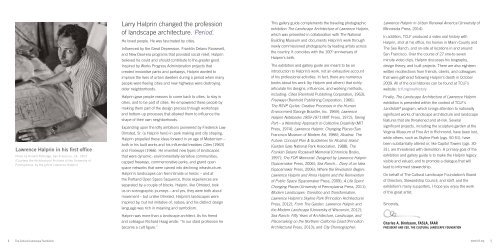Lawrence Halprin
halprin-gallery-guide_2016_finalspreads
halprin-gallery-guide_2016_finalspreads
You also want an ePaper? Increase the reach of your titles
YUMPU automatically turns print PDFs into web optimized ePapers that Google loves.
<strong>Lawrence</strong> <strong>Halprin</strong> in his first office<br />
Photo by Ronald Partridge, San Francisco, CA, 1953<br />
(Courtesy the Architectural Archives of the University of<br />
Pennsylvania, by the gift of <strong>Lawrence</strong> <strong>Halprin</strong>)<br />
Larry <strong>Halprin</strong> changed the profession<br />
of landscape architecture. Period.<br />
He loved people. He was fascinated by cities.<br />
Influenced by the Great Depression, Franklin Delano Roosevelt,<br />
and New Deal-era programs that provided social relief, <strong>Halprin</strong><br />
believed he could and should contribute to the greater good.<br />
Inspired by Works Progress Administration projects that<br />
created innovative parks and parkways, <strong>Halprin</strong> wanted to<br />
improve the lives of urban dwellers during a period when many<br />
people were fleeing cities and new highways were destroying<br />
older neighborhoods.<br />
<strong>Halprin</strong> gave people reasons to come back to cities, to stay in<br />
cities, and to be part of cities. He empowered these people by<br />
making them part of the design process through workshops<br />
and bottom-up processes that allowed them to influence the<br />
shape of their own neighborhoods.<br />
Expanding upon the lofty ambitions pioneered by Frederick Law<br />
Olmsted, Sr. (a <strong>Halprin</strong> hero) in park making and city shaping,<br />
<strong>Halprin</strong> propelled these ideas forward in an age of Modernism –<br />
both in his built works and his influential treatises Cities (1963)<br />
and Freeways (1966). He invented new types of landscapes<br />
that were dynamic: environmentally-sensitive communities,<br />
capped freeways, commemorative parks, and grand open<br />
space networks that were carved into declining infrastructure.<br />
<strong>Halprin</strong>’s landscapes can feel intimate or heroic – and at<br />
the Portland Open Space Sequence, those experiences are<br />
separated by a couple of blocks. <strong>Halprin</strong>, like Olmsted, took<br />
us on scenographic journeys – and yes, they were both about<br />
movement – but unlike Olmsted, <strong>Halprin</strong>’s landscapes were<br />
inspired by, but not imitative of, nature; and his distinct design<br />
language was rich in meaning and symbolism.<br />
This gallery guide complements the traveling photographic<br />
exhibition The Landscape Architecture of <strong>Lawrence</strong> <strong>Halprin</strong>,<br />
which was presented in collaboration with The National<br />
Building Museum and documents <strong>Halprin</strong>’s work through<br />
newly commissioned photographs by leading artists across<br />
the country. It coincides with the 100 th anniversary of<br />
<strong>Halprin</strong>’s birth.<br />
The exhibition and gallery guide are meant to be an<br />
introduction to <strong>Halprin</strong>’s work, not an exhaustive account<br />
of his professional activities. In fact, there are numerous<br />
books about his work (by <strong>Halprin</strong> and others) that richly<br />
articulate his designs, influences, and working methods,<br />
including: Cities (Reinhold Publishing Corporation, 1963);<br />
Freeways (Reinhold Publishing Corporation, 1966);<br />
The RSVP Cycles: Creative Processes in the Human<br />
Environment (George Braziller, Inc. 1969); <strong>Lawrence</strong><br />
<strong>Halprin</strong> Notebooks 1959-1971 (MIT Press, 1972); Taking<br />
Part – a Workshop Approach to Collective Creativity (MIT<br />
Press, 1974); <strong>Lawrence</strong> <strong>Halprin</strong>: Changing Places (San<br />
Francisco Museum of Modern Art, 1986); Alcatraz. The<br />
Future: Concept Plan & Guidelines for Alcatraz Island<br />
(Golden Gate National Park Association, 1988); The<br />
Franklin Delano Roosevelt Memorial (Chronicle Books,<br />
1997); The FDR Memorial: Designed by <strong>Lawrence</strong> <strong>Halprin</strong><br />
(Spacemaker Press, 2006); Sea Ranch... Diary of an Idea<br />
(Spacemaker Press, 2006); Where the Revolution Began:<br />
<strong>Lawrence</strong> <strong>Halprin</strong> and Anna <strong>Halprin</strong> and the Reinvention<br />
of Public Space (Spacemaker Press, 2009); A Life Spent<br />
Changing Places (University of Pennsylvania Press, 2011);<br />
Modern Landscapes: Transition and Transformation,<br />
<strong>Lawrence</strong> <strong>Halprin</strong>'s Skyline Park (Princeton Architectural<br />
Press, 2012); From The Garden: <strong>Lawrence</strong> <strong>Halprin</strong> and<br />
the Modern Landscape (University of Wisconsin, 2012);<br />
<strong>Lawrence</strong> <strong>Halprin</strong> in Urban Renewal America (University of<br />
Minnesota Press, 2014).<br />
In addition, TCLF produced a video oral history with<br />
<strong>Halprin</strong>, shot at his office, his homes in Marin County and<br />
The Sea Ranch, and on-site at locations in and around<br />
San Francisco. Over the course of 27 one-to-seven<br />
minute video clips, <strong>Halprin</strong> discusses his biography,<br />
design theory, and built projects. There are also eighteen<br />
written recollections from friends, clients, and colleagues<br />
that were gathered following <strong>Halprin</strong>’s death in October<br />
2009. All of the oral histories can be found at TCLF’s<br />
website: tclf.org/oralhistory<br />
Finally, The Landscape Architecture of <strong>Lawrence</strong> <strong>Halprin</strong><br />
exhibition is presented within the context of TCLF’s<br />
Landslide ® program, which brings attention to nationally<br />
significant works of landscape architecture and landscape<br />
features that are threatened and at-risk. Several<br />
significant projects, including the sculpture garden at the<br />
Virginia Museum of Fine Art in Richmond, have been lost,<br />
while others, such as Skyline Park (pgs. 50-51), have<br />
been substantially altered or, like Capitol Towers (pgs. 30-<br />
31), are threatened with demolition. A primary goal of the<br />
exhibition and gallery guide is to make the <strong>Halprin</strong> legacy<br />
visible and valued, and to promote a dialogue that will<br />
lead to informed stewardship.<br />
On behalf of The Cultural Landscape Foundation’s Board<br />
of Directors, Stewardship Council, and staff, and the<br />
exhibition’s many supporters, I hope you enjoy the work<br />
of this great artist.<br />
Sincerely,<br />
<strong>Halprin</strong> was more than a landscape architect. As his friend<br />
Sea Ranch: Fifty Years of Architecture, Landscape, and<br />
and colleague Richard Haag wrote: “In our staid profession he<br />
became a cult figure.”<br />
Placemaking on the Northern California Coast (Princeton<br />
Architectural Press, 2013); and City Choreographer:<br />
Charles A. Birnbaum, FASLA, FAAR<br />
PRESIDENT AND CEO, THE CULTURAL LANDSCAPE FOUNDATION<br />
4 The Cultural Landscape Foundation<br />
www.tclf.org<br />
5


